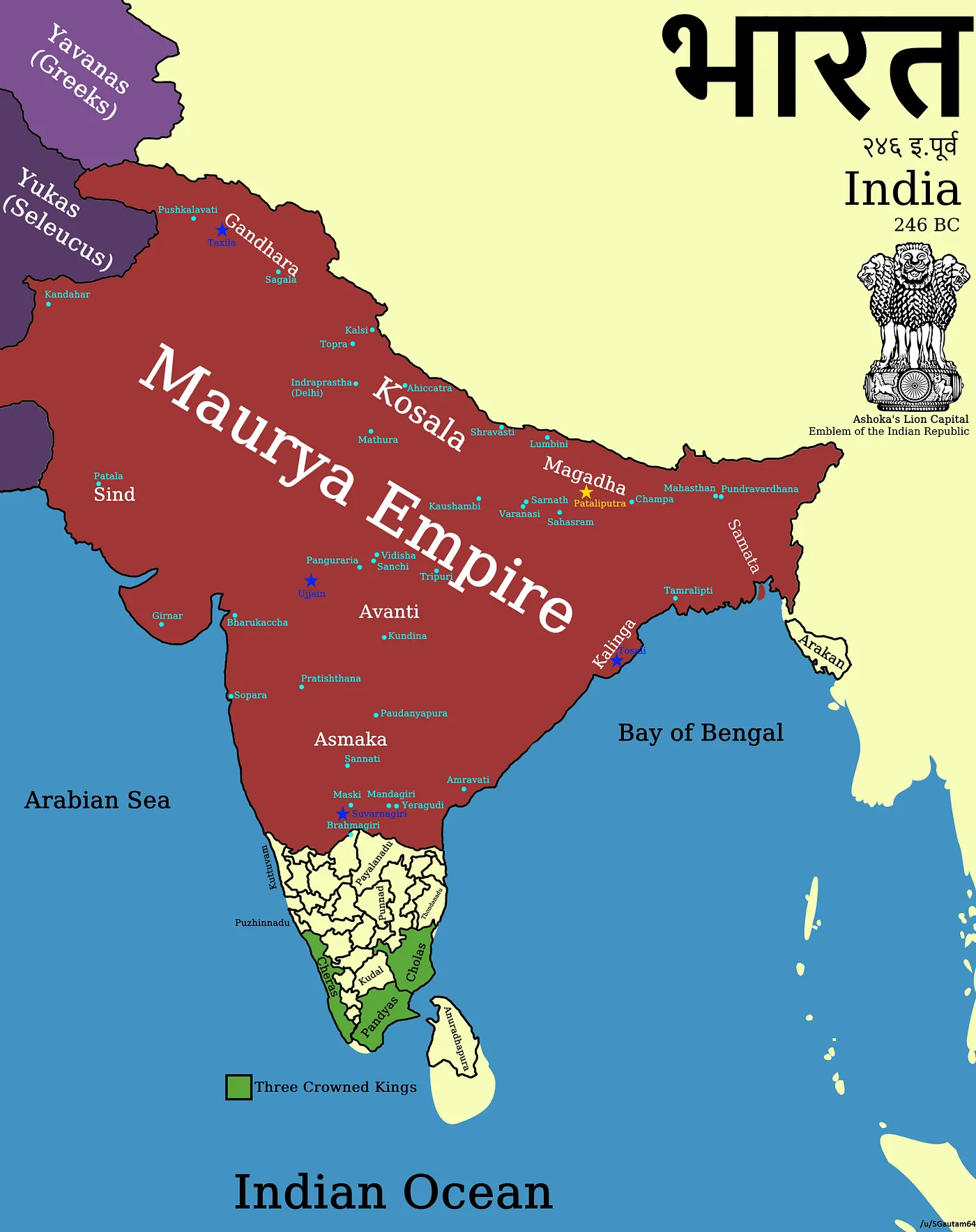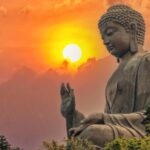Sources for Mauryan History
1. Literary Sources
- Kautilya’s ‘Arthasastra: It is the most important literary source for the Mauryas. It is a treatise on government and polity. It gives a clear and methodological analysis of political and economic conditions of the Maurya period.
- Megasthenese’s ‘Indica’: Megasthenese was the ambassador of Selecus Nikator in the court of Chandragupta Maurya. His
‘Indica’ is foremost among all the foreigners’ accounts for Maurya. But its original copy is lost, and it has survived only as quotations in the text of classical Greek writers, such as Strabo, Diodorous, Arrian, Plutarch and Latin writers such as Pliny and Justin. It refers to Mauryan administration, 7-caste system, absence of slavary and usuary in India etc.
>> Visakha Datta’s Mudra Rakshasa: Though it was written during Gupta Period, it describes how Chandragupta Maurya get Chanakya’s assistance to overthrow the Nandas.
>> Puranas: Though they are a collection of legends interspread with religious teachings, they give us the chronology and lists of Mauryan kings.
>> Buddhist Literature: 1. Indian Buddhist text Jatakas (a part of Khuddaknikaya of Suttapitaka which describes 549 stories of Buddha’s previous births) reveal a general picture of socio-economic conditions of Mauryan period.
2. Ceylonese Buddhist chronicles Dipavamsa and Mahavamsa describe the part played by Ashoka in spreading Buddhism to Sri Lanka. 3. Tibetan Buddhist text Divyavadana gives information about Ashoka and his efforts to spread Buddhism.
2. Archaeological Sources
>> Ashokan Edicts and inscriptions: There are Rock Edicts, Pillar Edicts and Cave Inscriptions located at several places in the Indian sub-continent. Their importance came to be appreciated only after their decipheration by James Princep in 1837 and also the identification of Ashoka as the author of these edicts in the beginning of the 20th century. Though Prakrit was the language used in them, the script varied from region to region (Kharosht in the North-West, Greek and Aramaic in the West and Brahmi in the East of India).
>> Other Inscriptions: Junagadh Rock Inscription of Rudradaman, Sohgaura Copper Plate Inscription in Gorakhpur district of U.P., Mahasthan Inscription in Bogara district of Bangladesh. – All these are directly concerned with the Mauryan Period.
>> Material Remains: Wooden palace of Chandragupta Maurya, Northern Black Polished Ware (NBPW), Silver and Copper punch-marked coins found in Kumharar (Patna) and other places are the material remains of the Mauryan period.
Origin of the Mauryas
>> The Puranas describe them as Shudras.
>> ‘Mudrakshasa’ of Vishakhadatta uses the terms Vrishal/ Kulhina (of low clan).
Chandragupta Maurya: 322 BC-298 BC
>> Chandragupta dethroned the last Nanda ruler Dhananand and occupied Patliputra in 322 BC with the help of Kautilya (Chankya).
>> In 305 BC, Chandragupta Maurya defeated Selecus Nikator, who surrendered a vast territory including Aria (herat), Arachosia (Kandhar), Gedrosia (Baluchistan) and Paropanisade (Kabul), in return for 500 elephants. According to treaty between Chandragupta and Selecus, the Hindukush became boundry between their states.
>> Megasthenese was a Greek ambassador sent to the court of Chandragupta Maurya by Selecus Nikator.
>> Chandragupta became a jain and went to Chandragiri Hill, Sravanbelgola (Karnataka) with Bhadrabahu, where he died by slow starvation (Kaya-Klesha/Salekhan).
Bindusara: 298 BC-273 BC
>> Chandragupta Maurya was succeeded by his son Bindusara.
>> Bindusara, known to the Greeks as Amitrochates (derived from the Sanskrit word Amitraghata i.e. slayers of foes), is said to have carried his arms to the Deccan (upto Mysore).
>> Bindusara patronised Ajivikas.
Ashoka: 273 BC-232 BC
>> According to Buddhist texts when Ashoka, the son of Bindusara, was born, his mother, happy to have a child, said, ‘Now I am Ashoka’, i.e., without sorrow:
And so the child was named.
>> According to Buddhist tradition, Ashoka usurped the throne after killing his 99 brothers and spared Tissa, the youngest one. Radhagupta a minister of Bindusara helped him in fratricidal struggle.
>> This war of succession accounts for interregnum of four years (273-269 BC), and only after securing his position on the throne, Ashoka had himself formally crowned in 269 BC.
>> Under Ashoka, the Mauryan Empire reached its climax. For the first time, the whole of the sub-continent, leaving out the extreme south, was under imperial control.
>> Ashoka fought the Kalinga war in 261 BC in 9th years of his coronation. The king was moved by the massacre in this war and therefore abandoned the policy of physical occupation in favour of policy of cultural conquest. In other words, Bherighosa was replaced by Dhammaghosa.
Later Mauryas: 232 BC-185 BC
>>The Mauryan dynasty lasted 137 years.
>> Ashoka’s death was followed by the division of the Mauryan Empire into two parts-Western and Eastern.
The Western part came to be ruled by Kunala (son of Ashoka) and the Eastern part came to be ruled by Dasaratha.
>>The last Mauryan ruler, Brihadratha, was assassinated in 185 BC by his commender-in-chief, Pushyamitra Sunga, who established his own Sunga dynasty.
Economy
>> Tax collected from peasants varied from 1/4 to 1/6 of the produce.
>> The state also provided irrigation facilities (Setubandha) and charged water. tax.
>> Sohgaura (Gorakhpur district, U.P.) copper plate inscription and Mahasthana (Bogara district, Bangladesh) inscription deal with the relief measures to be adopted during a famine.
>> Important ports: Bharukachch/Bharoch and Supara (Westerncoast), Tamralipti in Bengal (Eastern coast).
Society
>> Kautilya’s ‘Arthashastra’ looked upon the Shudras as an Aryan community which is distinguished from Malechha or non-Aryan community.
>> Reduction of gap between the Vaishyas (most of whom were now concentrating on trade though others continued cultivation) and the Shudras (quite a few of whom were now agriculturists and others being artisans).
>> Magasthenese states that Indian society was divided into 7 classes :
Philosophers 2. Farmers 3. Soldiers 4. Herdsmen 5. Artisans 6. Magistrates 7. Councillors.
Mauryan Art
>> Anand Coomarswamy classified Mauryan Art into two groups :
1. Royal/Court Art : The Royal Palace of Chandragupta Maurya (Kumharan Patna) and City of Patliputra, Ashokan Pillars, Caves, Stupas etc.
2. Folk/Popular Art: 1. Figure Sculpture of Yaksha-Yakshini etc. e.g. Yaksha ol Parkham (Mathura), Yakshini of Besanagar / Vidisha (M.P.), Chanwar-bearer Yakshini of Didargani (Patna). 2. Terracotta objects. 3. Inscribed stone portrait of Emperor Ashok/ Broken relief sculpture of Emperor Ashok (Kanaganhalli, Karnataka).
>> The Mauryas introduced stone masonry on large scale during Ashoka. Fragments of stone pillars and wooden floor and ceiling indicating the existence of an 80-pillared hall have been discovered at Kumhrar on outskirts of Patna. Seeing this Fahien remarks as follows: ‘These palaces are so beautiful and excellent that they appear to be the creation of God rather than of men’.
>> Four lion capital at Sarnath and Sanchi. Lioned capital of Sarnath was adopted as ‘National Emblem’ of India on 26 Jan., 1950.
>> The Mauryan artisans who started the practice of hewing out caves from rocks for monks to live in. The earliest example are Barabar caves (Sudama, World Hut, Chaupada of Karna, Rishi Lomesh) in Gaya (Ashokan). The other examples are Nagarjuni caves in Gaya (Dasharath).
Featured Image Courtesy: Medium



